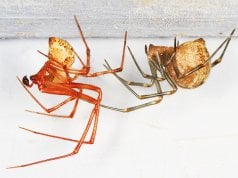The Bay Cat is an endangered cat species that lives in Borneo. Researchers believe their closest relative is the Asian golden cat, which lives across various parts of Asia.
This species lives only on the island of Borneo, and scientists believe that their populations contain no more than 2,200 adult cats. In fact, these felines are so elusive that researchers have difficulty even finding them! Read on to learn about the Bay Cat.
Description of the Bay Cat
This cat looks a little like a small cougar or a jaguarundi. They have lean bodies, long tails, and reddish-brown or grey fur. Their ears are small and round, and their eyes are large and light colored.
These cats usually weigh seven or eight pounds and measure about two feet long. However, researchers have only been able to measure a handful of these elusive cats, so we don’t know how accurate these sizes are when you compare them to the rest of the population.
Interesting Facts About the Bay Cat
Scientists know very little about this cat. In fact, researchers have very few specimens and photographs, much less behavioral observations. Here are some interesting things we do know about these cats.
- Camera Traps – Before researchers began using camera traps, people rarely spotted living Bay Cat Even with the use of camera traps, scientists still have a difficult time recording them. In fact, they are finding that some of the areas they assumed they lived might have no populations at all!
- Sneaky Feline – Unsurprisingly, because it is so difficult to study this cat, scientists know very little about them. Bay Cats are actually one of the least known cat species in the world, simply because we just can’t find them. Scientists think that on top of habitat loss, bays cats naturally have smaller population numbers than some other felines.
- The Palm Oil Problem – Like many Bornean species, populations of these felines suffer from the palm oil industry. Farmers cut down natural forests to plant oil palm plantations. In the process, they destroy suitable habitat for the cats and many other animals, like orangutans. Through several studies researchers have concluded that Bay Cats do not use oil palm plantations to live in.
Habitat of the Bay Cat
Scientists do not have extensive information about the preferred habitats of this species. However, recent camera trap studies have given us some information about what areas this cat inhabits.
Researchers have spotted these cats in dense forest, rocky limestone, and in some partially logged forests. Some evidence shows that they also inhabit riparian areas in close proximity to streams and rivers.
Distribution of the Bay Cat
These cats only live on the island of Borneo. Their range is restricted to areas with suitable forest habitats for them to live in. Researchers believe that most of them live in the inland regions of Borneo. Camera trap studies are also revealing that the cats might not live in quite as extensive an area as researchers previously believed.
Diet of the Bay Cat
When it comes down to it, researchers aren’t exactly sure what Bay Cats eat because no one has ever watched one hunt. However, like all felines these cats are carnivores and eat only meat. Scientists believe that they prey on small mammals, birds, monkeys, and more.
Bay Cat and Human Interaction
Humans and Bay Cats rarely interact directly. With that said, people impact these felines heavily, primarily through habitat destruction.
Bay Cats live in dense forests and cannot survive in palm plantations. When people cut down the forest to plant oil palms, the cats suffer heavily. This activity, when combined with trapping and hunting, cause these cat populations to continually decline. The IUCN lists the Bay Cat as Endangered.
Domestication
Humans have not domesticated Bay Cats in any way.
Does the Bay Cat Make a Good Pet
No, these animals do not make good pets. Even if you could find one, these cats are incredibly shy. Their populations are also in decline, and every individual is important for the survival of the species. Because of this it is illegal to own a Bay Cat as a pet.
Bay Cat Care
No one has successfully kept these cats in zoos or in captivity. Researchers do not know what these cats need in human care to live healthy lives. The lack of these cats in human care also prevents them from developing a successful breeding program.
Behavior of the Bay Cat
Researchers know very little about Bay Cat behavior. We know that these cats are terrestrial, because camera traps on the ground have captured images of them walking from place to place.
We also know that they are solitary, because these camera traps have not captured any evidence of cats travelling together or socializing. Most traps catch images of cats during the day, suggesting that they might be diurnal, but they have also recorded activity at night.
Reproduction of the Bay Cat
Scientists have no information about the reproductive rates or strategies used by Bay Cats.
















![Red Angus Closeup of a beautiful Red Angus cowPhoto by: U.S. Department of Agriculture [pubic domain]https://creativecommons.org/licenses/by/2.0/](https://animals.net/wp-content/uploads/2020/03/Red-Angus-4-100x75.jpg)

